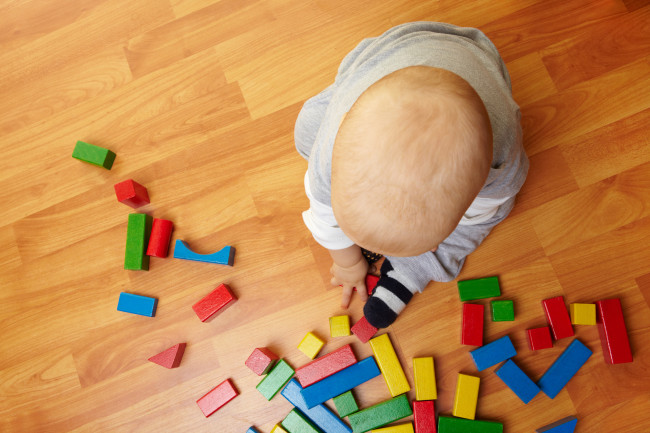For a child between the age of six and 12 months; their physical-motor development should see improved leg and foot strength. Your baby should also be able to crawl forwards and backwards, and even turn around and use their hands voluntarily as well as demonstrate hand preferences.
Social-emotional development is also evident; you can gauge this by seeing if they are responsive when spoken to, if they long for encouragement and praise. He or she should also respond to and understand words and sounds and react to an audience and on praise repeat their action. Your baby should also give affection, and they should recognise their family members.
There are no age specific activities to do with a seven-month-old, but there are things you can do between the ages of seven and 12 months:
Physical-motor development activities:
- Aeroplane: it is imperative that the child moves through space. They love this, and its very good for their brain development. Move the child through the air back and forth, left and right, around and around.
- Place your baby on a blanket on the floor – then get other siblings to help move the baby around and around.
- Allow your child to sit in your lap, facing away from you with their legs on your legs. Then lift their one leg up, lean it to one way, roll them over.
- Get your child to spend time on their tummies, and reach for and play with hanging objects.
- Roll your child back and forth,
- When pulling a child up, pull their left hand towards their right knee.
- Wrap a toy in bright coloured paper – allow your child to unwrap this, as it will aid in enhancing fine-motor development as well as excitement and fun!
- Encourage your baby to hold objects, to grip them and keep control over objects. They should be able to clutch toys.
Play development activities:
- Play skittles with objects filled with rice so that it makes a noise. Hold the baby standing up, and help him roll a big ball onto the skittles.
- Play peek-a-boo games, particularly with a favourite toy, or something that makes a noise. Hide half the objects away at first, under a blanket. Rattle it, so that the baby knows its still there. Then reveal it. Do this a few times.
- Any child loves songs, books, rhymes, poems! Use actions, make it fun for the children, and allow them to anticipate the next action. As they get used to the songs, they will be able to anticipate movements.
- Explain body parts, constantly talk to them about parts of their body that they are using, and explain purpose of parts.
- Hide an object under the napkin. This will help teach the child the concept that although he can not see something, it is still there. This develops abstract thinking skills.
Cognitive development activities:
- Texture in the environment: Walk around the house, and take the baby on a texture tour. Allow them to feel the curtains, ornaments, the trees, grass, stones, etc.
- Bubble bath: This is a great sensation for your baby, and at the same time is good for hide and seek games.
- Allow your child to play and explore on his own. They need to be able to learn through experiences, and by giving them the time to do so, is great.
- Have a small bowl with sand in, and get your child to pull the safe objects out from the sand.
- Stickers off clothing: A great way to enhance laterality, crossing the mid-line and bilateral co-ordination.
- Give your child toys, which he can use to make a noise with – tupperware, wooden spoon, pots, drums, blocks, etc.
- Encourage your child by clapping your hands when they do something right. Show them how to clap their hands, and then allow them to do this.
Language and speech development activities:
- Expose your baby to many animal sounds and sounds from the environment – then explain what that noise was. Repetition is key.
- Use material or plastic books, as your baby will surely try and put the book in their mouth. The books should have simple pictures or babies and animals.
- Pulling funny faces and making noises will create an opportunity for the child to begin imitation. This will enhance their social and language development. Activities such as sticking out the tongue, opening the mouth are all good.
These are only but a few suggestions of what you can do with your child to encourage their development both physically and mentally. React to your child, what they enjoy and encourage their participation with you and other family members and close friends.
That’s the WHAT and WHY. For the HOW, contact [email protected].
About the Author: Dr. Lauren Stretch is the founder of Early Inspiration, an organisation which aims to enhance the development of young children in South Africa through practitioner training and home interventions. She is one of the youngest PhD graduates in the country, and has completed her studies in the effectiveness of pre-school teachers, particularly in underprivileged settings, at the University of South Africa (UniSA).
Latest posts by Contributor (see all)
- What you didn’t know about newborn skin - December 15, 2014
- Real life: My toddler is easily distracted - December 15, 2014
- Advice for a mom whose toddler is not speaking - December 12, 2014
-
No Comments" href="https://all4baby.co.za/newborns-0-6-months/2652/tummy-time-important/">

Tummy time – why it’s important
-
No Comments" href="https://all4baby.co.za/toddlers-1-2-years/learning-development-1-2-years/2513/child-able-draw-straight-line/">

When should my child be able to draw a straight line?
-
No Comments" href="https://all4baby.co.za/babies-6-12-months/learning-development/2445/babys-sense-touch-importance-texture/">

Your baby’s sense of touch and the importance of texture
-
No Comments" href="https://all4baby.co.za/babies-6-12-months/learning-development/2423/3-ways-encourage-reading-toddler-using-picture-books/">

3 Ways to encourage reading in your toddler, using picture books


 Saving...
Saving...